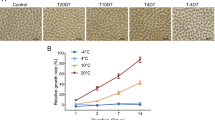Abstract
Various stresses, including exposure to cold or heat, can result in a sharp increase in pigmentation of sea urchin embryos and larvae. The differentiation of pigment cells is accompanied by active expression of genes involved in the biosynthesis of naphthoquinone pigments and appears to be a part of the defense system protecting sea urchins against harmful factors. To clarify numerous issues occurring at various time points after the cold injury, we studied the effect of shikimic acid, a precursor of naphthoquinone pigments, on cell viability and expression of some pigment genes such as the pks and sult before and after freezing the cultures of sea urchin embryo cells. The maximum level of the pks gene expression after a freezing–thawing cycle was found when sea urchin cells were frozen in the presence of trehalose alone. Despite naphthoquinone pigments have been reported to possess antioxidant and cryoprotectant properties, our data suggest that shikimic acid does not have any additional cryoprotective effect on freezing tolerance of sea urchin embryo pigment cells.
Similar content being viewed by others
References
Adams, S.L., Hessian, P.A., and Mladenov, P.V., The potential for cryopreserving larvae of the sea urchin, Evechinus chloroticus, Cryobiology, 2006, vol. 52, no. 1, pp. 139–145.
Ageenko, N.V., Kiselev, K.V., and Odintsova, N.A., Expression of pigment cell-specific genes in the ontogenesis of the sea urchin Strongylocentrotus intermedius, J. Evidence-Based Complementary Altern. Med., 2011. doi 10.1155/2011/730356
Beeble, A. and Calestani, C., Expression pattern of polyketide synthase-2 during sea urchin development, Gene Expression Patterns, 2012, vol. 12, nos. 1–2, pp. 7–10.
Bellas, J. and Paredes, E., Advances in the cryopreservation of sea urchin embryos: potential application in marine water quality assessment, Cryobiology, 2011, vol. 62, no. 3, pp. 174–180.
Britton, G., The Biochemistry of Natural Pigments, London: Cambridge Univ. Press, 1983.
Calestani, C., Rast, J.P., and Davidson, E.H., Isolation of pigment cell specific genes in the sea urchin embryo by differential macroarray screening, Development, 2003, vol. 130, no. 19, pp. 4587–4596.
Cameron, R.A. and Davidson, E.H., Cell type specification during sea urchin development, Trends Genet., 1991, vol. 7, no. 7, pp. 212–218.
Gibson, A.W. and Burke, R.D., The origin of pigment cells in embryos of the sea urchin Strongylocentrotus purpuratus, Dev. Biol., 1985, vol. 107, no. 2, pp. 414–419.
Kiselev, K.V., Ageenko, N.V., and Kurilenko, V.V., Involvement of the cell-specific pigment genes pks and sult in the bacteria defense response of the sea urchin Strongylocentrotus intermedius, Dis. Aquat. Org., 2013, vol. 103, no. 2, pp. 121–132.
Materna, S.C. and Davidson, E.H., Logic of gene regulatory networks, Curr. Opin. Biotechnol., 2007, vol. 18, no. 4, pp. 351–354.
Matranga, V., Toia, G., Bonaventura R., et al., Cellular and biochemical responses to environmental and experimentally induced stress in sea urchin coelomocytes, Cell Stress Chaperon, 2000, vol. 5, no. 2, pp. 113–120.
Naidenko, T.Kh., Cryopreservation of Crassostrea gigas oocytes, embryos and larvae using antioxidant echinochrome A and antifreeze protein AFP1, Cryo-Letters, 1997, vol. 18, no. 6, pp. 375–382.
Odintsova, N.A., Ageenko, N., Kiselev, K., et al., Analysis of marine hydrobiont lipid extracts as possible cryoprotective agents, Int. J. Refrig., 2006, vol. 29, no. 3, pp. 387–395.
Odintsova, N.A., Ageenko, N.V., Kipryushina, Yu.O., et al., Freezing tolerance of sea urchin embryonic cells: Differentiation commitment and cytoskeletal disturbances in culture, Cryobiology, 2015, vol. 71, pp. 54–63. doi org/10.1016/j.cryobiol.2015.06.002
Odintsova, N.A. and Boroda, A.V., Cryopreservation of the Cells and Larvae of Marine Organisms, Russ. J. Mar. Biol., 2012, vol. 38, no. 2, pp. 101–111.
Paredes, E. and Bellas, J., The use of cryopreserved sea urchin embryos (Paracentrotus lividus) in marine quality assessment, Chemosphere, 2015, vol. 128, pp. 278–283.
Pinsino, A. and Matranga, V., Sea urchin immune cells as sentinels of environmental stress, Dev. Comp. Immunol., 2015, vol. 49, no. 1, pp. 198–205.
Author information
Authors and Affiliations
Corresponding author
Additional information
This work was presented at the International Conference “The cell cultures of marine and freshwater animals,” Vladivostok, Russia, September 8–10, 2015.
The article is published in the original.
An erratum to this article is available at http://dx.doi.org/10.1134/S1063074016060110.
Rights and permissions
About this article
Cite this article
Ageenko, N.V., Kiselev, K.V. & Odintsova, N.A. Freezing tolerance of sea urchin embryo pigment cells. Russ J Mar Biol 42, 437–441 (2016). https://doi.org/10.1134/S1063074016050023
Received:
Published:
Issue Date:
DOI: https://doi.org/10.1134/S1063074016050023




